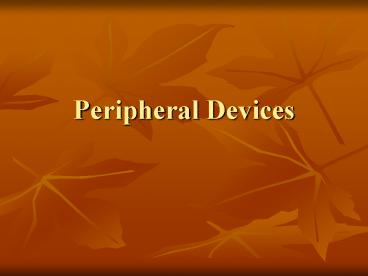Peripheral Devices - PowerPoint PPT Presentation
1 / 12
Title:
Peripheral Devices
Description:
Second effort employed an electric controller to constantly scan for keystrokes, ... Flatbed Scanners- resemble the top half of a photocopier- they employ a charge ... – PowerPoint PPT presentation
Number of Views:1593
Avg rating:3.0/5.0
Title: Peripheral Devices
1
Peripheral Devices
2
Keyboards
- Keyswitch Keyboards- employ an individual switch
under each key- a plunger moves downward in
response to a key press, making a connection
between two signal lines coming from the keyboard
controller - Inexpensive
- Simple to make
- Simple to service
- Bounce led to duplicate letters, but decreased
tension leads to finger fatigue - Bulky
- Require Voltage to operate
- Second effort employed an electric controller to
constantly scan for keystrokes, ignoring those
which are not present for a second scan
3
Capacitive Keyboards
- Placed two sheets of semi-conductive materials
separated by a thin sheet of Mylar inside the
keyboard- a key press creates contact between the
sheets changing the capacitance- the controller
is aware of which key is pressed by reading a
scan code - You cannot repair capacitive switch keyboards
- Durable
- Inexpensive
4
Keyboard Connectors
- DIN 5- standard on the IBM PC or XT/AT form
factor machines - Mini- PS/2- smaller then the DIN 5- so named
because it was initially introduced on the IBM
PS/2
5
Cleaning Keyboards
- Remove it from the computer and soak it in
distilled, demineralized water as soon as a spill
occurs - A dry spill is much harder to clean
- Running keyboard through the dishwasher is not
recommended - Be sure the keyboard is completely dry before
reconnecting it and using it - Disassemble and use a special keyboard cleaner
- Due to the amount of time this method requires,
it is cheaper to simply buy a new keyboard
6
The Mouse
- GUI- Graphical User Interface- the use of
pictures to represent computer entities or basic
commands (i.e.- save, exit) - Mouse- a device specifically designed to interact
with the pictures represented in a GUI interface-
translates moves on a horizontal surface into
movements of a pointer on the screen
7
Types of Mice
- Opto-mechanical- contains a round ball that makes
contact with two internal rollers representing
the x and y axis respectively- optical sensors
interpret light patterns as speed and direction
of movement and send those to the mouse control
software on the computer - An Optical Mouse has no ball- rather it uses a
special mouse pad and a beam of laser light- the
pad reflects the laser back to a sensor in the
mouse that detects movement and direction - Will not work without the special mouse pad
8
Mouse Interfaces
- Serial the first major mouse interface was a
DB9 serial - Major disadvantage was the use of a COM port
- Bus Interface- an expansion card with a PS/2
connector - Did not take up a COM port, but it does use an
interrupt - PS/2 Mouse Interface- the same PS/2 connector
integrated on the motherboard
9
Cleaning the Mouse
- 1. Turn the mouse upside down and remove the
ball by rotating the retaining ring - 2. Flip the mouse upright so the ball will fall
out - 3. Use a small eyeglass screwdriver to remove
the circular accumulation of dust and dirt on the
rollers - 4. If needed, soak in isopropyl alcohol to
loosen - 5. Reassemble
10
Other Pointing Devices
- Trackballs- essentially an upside-down mouse- the
ball moves while the casing is stationary-
typical trackballs are large desktop style-
portable trackballs are more compact and may be
held in the hand - Drawing Tablets- a sheet of plastic with a
rubberized coating on which a user my use a
stylus to draw images - Electromagnetic Tablets- tablet has a grid of
wires across which an electrical pulse is sent at
regular intervals- a sensor in the stylus
translates the signals to x and y coordinates - Resistive Tablets- have a resistive surface under
the rubberized coating that induces variable
current at different spots on the x and y axis
translating to specific coordinates - Acoustic Tablets- stylus has a small spark which
activates at the press of a button- microphones
on the x and y axis translate the coordinates
into values for the computer - Touch Screens- a screen which is sensitive to
touch - Optical- the physical touch breaks a beam of
light emanating from the screen to determine x
and y coordinates\ - Capacitive screens- like the keyboards, employ
two sheets of clear plastic separated by a layer
of air- touching a particular spot changes the
total capacitance and translates to an x, y
coordinate
11
Scanners
- Flatbed Scanners- resemble the top half of a
photocopier- they employ a charge coupled device,
a motorized carriage, and a light source to
convert images in to computerized files - Usually SCSI
- Can be manufacturer proprietary
- Handheld Scanners- contain all the same
components in a smaller enclosure with wheels - Inexpensive
- Decent Capabilities
- Slow
- Quality Depends Largely on User
- Scanners may be cleaned carefully with glass
cleaner
12
Modems
- Modem actually stands for Modulator/Demodulator-
digital signals can lose strength over long
distances- analog signals may get weaker, but the
sound does not degrade- therefore, analog signals
are a better choice for communication over a
telephone line. The modem translates the digital
signals from the computer to analog signals for
transmission and visa versa - Modem Signal Abbreviations
- OH- Off the Hook
- SD(TX) Transmit Data
- RD(RX) Receive Data
- AA Auto Answer































